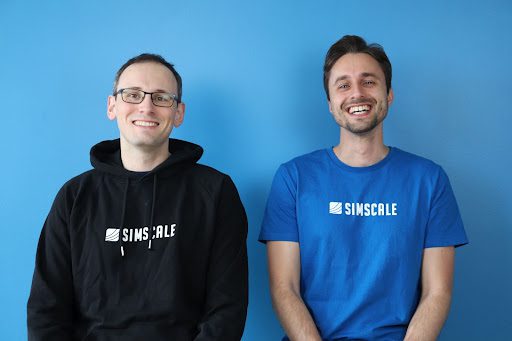For today’s article, I met with Mariano Barrios, VP of Engineering at SimScale, to speak about the changes he has seen during his time at SimScale, our philosophy, and engineering culture. Mariano joined SimScale almost 7 years ago when our engineering teams consisted of around 20 people. Since then, the company has grown organically, which helped to create and maintain a culture of continuity.
Mariano, how did SimScale’s engineering culture evolve over the years?
One element of our culture—and this is kind of recent—is related to the fact that many companies in the software industry at large have problematic or less than ideal relationships between engineering and product management. Many see a benefit in separating the disciplines or making them not interact as equals, which in the end produces some kind of artificial one-dimensional trade-off or even conflict. We try to frame the relationship with product management, first, as equals, and second, as working together solving problems—problems usually presented by product management as such, not as solutions to be implemented. If we work collaboratively, we will have a better outcome in the long run.
What differentiates our engineers from others?
We look, as a start, for outstanding technical ability in our team members. For engineers, it’s also important to focus on people who see knowledge as a means to an end and not as an end in itself, who like to find solutions for problems, not the other way around. The combination of this attribute and the technical excellence is the magic touch… Hiring it’s a bit of an art and, although we have good processes in place, we recognize the subjective element, and give space to it. I also still personally get involved in every single hiring as we recognize that involvement from the leadership team will help us maintain excellence and culture.
What does it take to build a world-class engineering culture?
It’s in the end about talent and being very conscious about its density in the team and how to continuously increase it. This is the place where everything starts. We have always had a strong desire to seek talent. I know it’s a cliche but I believe it, and it’s in the end easier said than done. Many things just become easier regarding management and impact when you start with high talent density.
How do our Engineering teams work?
We take ownership very seriously, which means that specific teams own specific components and KPIs (“key performance indicators”; that is, metrics) in a very concrete way. We make those ownerships stable in time, which is a key element to aligning long- and short-term incentives. Coming from our mission—bringing simulation to the cloud, and democratizing it—implies, technically, having a diverse team, composed of mainstream computer scientists (backend and frontend developers), and also what we may call domain experts, people who specialize in the different aspects of simulation: CAD, meshing, and the solvers. Something that can be seen many times in our industry is some kind of a cultural division between domain experts and computer scientists: this may lead to a breakdown in communication and in the end bad results. We try to compensate for that bias that may exist in the market, by considering each of the roles as equal and by thinking in terms of what each different background can contribute. Of course, this and many other cultural traits that we wish to cultivate need constant energy from our leadership team. In the end, it’s about communication and making our culture explicit.
How do we allow people to grow and develop?
Firstly, exposure to interesting problems, which are not easy to solve, is, I believe, the main source of growth for everyone. Secondly, the context of the team, that is, learning from each other. I am convinced that these are the main sources of true career advancement that you can find. At SimScale, we try to see growth more as something that happens inside the person; recognition just comes after the impact that the person makes. This impact can be achieved by leading people, but also could be as an individual contributor, making changes that have advanced the technology and the business.
We always emphasize our hands-on culture. What does that mean?
A lot of companies see engineering leadership as something different to a technical career. Indeed, talking about individual contributor paths has become quite standardized. While giving concrete growth opportunities to individual contributors is undoubtedly a good thing, at SimScale we avoid separating these two roles too much, as it would happen by offering divergent career paths. We believe in leaders—people leaders—that exercise leadership from a technical perspective and don’t detach from the details. It’s all about caring about the impact of the work—what matters—and not just moving issues in the tracker, so to speak. It’s also not about telling people what code to write, but the simple fact that making good management decisions just requires knowing the details.
What makes SimScale a challenging environment?
Firstly, solving physics using computers is still an open problem and is the most obvious challenge in our industry. Secondly are the challenges that come with being cloud-native. At SimScale, we are in a sense our own benchmark as there are many products that do similar things but on-premises. Bringing this technology to the cloud brings its own set of problems! Some things that are easy on the desktop, might be a bit more difficult on the cloud. Back to the first point, dealing with problems in engineering allows us to be ambitious. Of course, we can’t solve everything, some things might take too long, but we always take the chance.
Why would someone decide to join SimScale?
Each story is different. For people from the simulation world, it’s often about the challenge, as many players in the industry are unfortunately not innovating fast enough. This happens to many big companies and it can be natural for some people to move to places that are more disruptive. For software developers at large, an interesting factor is that the software industry, and its market, are huge, but not many companies may offer such a unique and challenging product to work on. At SimScale, we can confidently say that we can offer very interesting problems. This represents the biggest motivator for someone who derives intrinsic motivation from such things.
Thank you, Mariano, for all the insights!
Stay tuned for more insights into SimScale and see what the team has been up to on our @lifeatsimscale Instagram feed. Want to start your own SimScale story? Make sure to keep an eye on our careers page for possible openings!




